by Joe Domaleski | Jul 17, 2023 | Blog, Business, Columnists, Community, News Center, Opinion
This is our twentieth year in business! Owning my business, Country Fried Creative, has been one of the most fulfilling things I’ve ever done, but it’s also been one of the hardest. When times are good, everyone is your friend. When times are tough, friends are scarce. I’ve been asked many times what are the things I don’t like about running a small business. Although I’m not a negative person, I am human, and there are things that test my patience. In no particular order, here’s my top 10 list of least favorite things I deal with as a small business owner.
- Taxes: Taxes are a headache. It’s one thing to handle taxes as an employee, which are deducted from your paycheck. Most people don’t know what it’s like being the employer and having to manage taxes and payroll. Big companies get tax credits, small companies get audits. Big companies know the tax code better than the government, small companies don’t. Navigating the intricacies of tax laws, unemployment insurance, and other payroll compliance is time-consuming and overwhelming. Fortunately, I have great advisors. Small businesses should have a reduced paperwork and tax burden. I don’t mind paying my fair share, but gee whiz.
- Government Red Tape: I’m not anti-government. We need a government to maintain social order, provide public services, and support public safety. On the other hand, the amount of bureaucratic red tape for a small business owner is overwhelming. The complex web of regulations, permits, licenses, and paperwork is daunting and time-consuming. Bureaucracy hinders productivity and diverts attention away from core business operations. I applaud efforts to move some of the paperwork burden online, yet some of it still requires paper – like real paperwork that has to be notarized. Really? It’s 2023 and I can open a bank account without a notary, but I can’t submit certain forms without it. Makes no sense. There should be a streamlined set of regulations and filings for small businesses.
- People Who Don’t Want to Be Bothered with Details, Until They Do: Interacting with individuals who show disinterest in details until a problem arises is very frustrating. Whether it’s suppliers, employees, or clients, encountering those who neglect important details is a big challenge. No one wants to drown in details, yet details matter. My client contracts are two pages long, yet I still have some people who won’t read the contract. Those same people will take exception when a contractual issue arises. They will tell me with a straight face, “I didn’t read it because I didn’t want to be bothered with details. But now that I’ve read it, I disagree with it.” Huh?
- Clients Who Abandon Projects: One of the most disheartening aspects of being a small business owner of a service company is when clients abandon projects midway. It doesn’t happen often, but it does happen more than it should. Usually, it’s not an overt abandonment; a client simply disappears. Despite investing time, effort, and resources, some clients may abruptly become non-responsive, effectively abandoning a project. This leaves us with unfinished work and reduced revenue. I know many businesses deal with this – unclaimed merchandise, cars, property, etc. If someone needs to “take a pause,” then say so. Don’t just disappear.
- Cash Flow Management: Managing cash flow is not something taught in business school. Just because you do work and invoice it doesn’t mean it’ll get paid promptly. Employees expect to get paid on payday, but clients don’t always treat small business vendors the same way. Late payments from clients, unexpected expenses, holidays, and seasonal fluctuations disrupt cash flow and hinder day-to-day operations. Over the years, I’ve become pretty good at managing cash flow, but those early years were tough. If you have a vendor who’s a small business, please know that your payment to them might be their next mortgage payment – have a heart.
- Dealing with Complaints: Handling customer complaints is emotionally taxing. I dare say that most business owners take pride in their craft and genuinely want their customers to be happy. When customers aren’t happy, we’re not happy. While striving to provide excellent customer service, encountering dissatisfied customers is inevitable. Most people are reasonable. I’d say that 95% of all customer complaints we’ve ever had were resolved in a positive manner that made the customer relationship even stronger. Occasionally, we’ll run into someone who just doesn’t want to be happy – that’s frustrating. We try not to take those people on as clients, but sometimes organizations change leaders, causing us to adapt to a new leader. We have fired unreasonable clients, and it’s important that my employees know I have their back.
- Making Do with Limited Resources: We small business owners face the challenge of accomplishing big goals with limited resources. When someone asks me to join an organization, donate to a cause, or sponsor something – that money is coming out of my own pocket, not some big company bank account. Limited resources don’t just mean money; it also means staff, technology, and other resources. We have to be both efficient and effective to make the most of our limited resources. It’s amazing what we can do with our small, but mighty team. On the other hand, just because I have fifteen team members doesn’t mean that I can afford to put all of them on your project – someone has to “mind the store.”
- Being Needed During Tough Times, But Abandoned During Good Times: During COVID, we became a lifeline for several local organizations (who’ll remain nameless). As people sheltered in place, digital marketing (the service we provide) became essential. Our clients needed us to help them communicate with their own customers electronically. Everyone was at home glued to a computer. It gave us a renewed sense of purpose to be the go-to company during those challenging times. In fact, we lowered our rates and gave very favorable terms to many of our customers who were struggling financially. As the pandemic died down, we were proud of having helped more than one business “survive and thrive.” Yet, some of those same organizations we helped save decided to change agencies away from us to non-local companies after their fortunes improved. When asked why, they told us they simply wanted to go a new direction. I guess our good favors weren’t really appreciated. It’s hard not to take something like that personally. Nothing lasts forever, but it hurts when you help someone and then they walk away.
- Accounts Receivable: I’ve written previously about managing accounts receivable. Late or unpaid invoices negatively impact cash flow, creating additional financial stress. Bills, taxes, and payroll come in with startling regularity. Income does not. I’ll work with anyone who is willing to work with us on terms. We’re a small enough business that I personally contact clients who are late paying their invoices. I don’t like doing it, and I’ve tried delegating it to other people, yet it always comes back to me. For those of my clients who are reading this and do pay on time and/or are on auto-payment plans – thank you, it means more to me than you might know!
- People Who Don’t Follow-Up: Every week, I get “urgent” requests for quotes and meetings for “special projects.” I try to be friendly, but I’ve learned over the years that the supposedly urgent “how fast can you build a website” requests almost always mean the exact opposite. I’m not sure if people are that way because they’ve been burned by other people or if society as a whole is really that impatient. Sometimes the urgent requests come from clients who ask us something and then disappear when we need to follow-up with them about it. It’s frustrating. We deal with it.
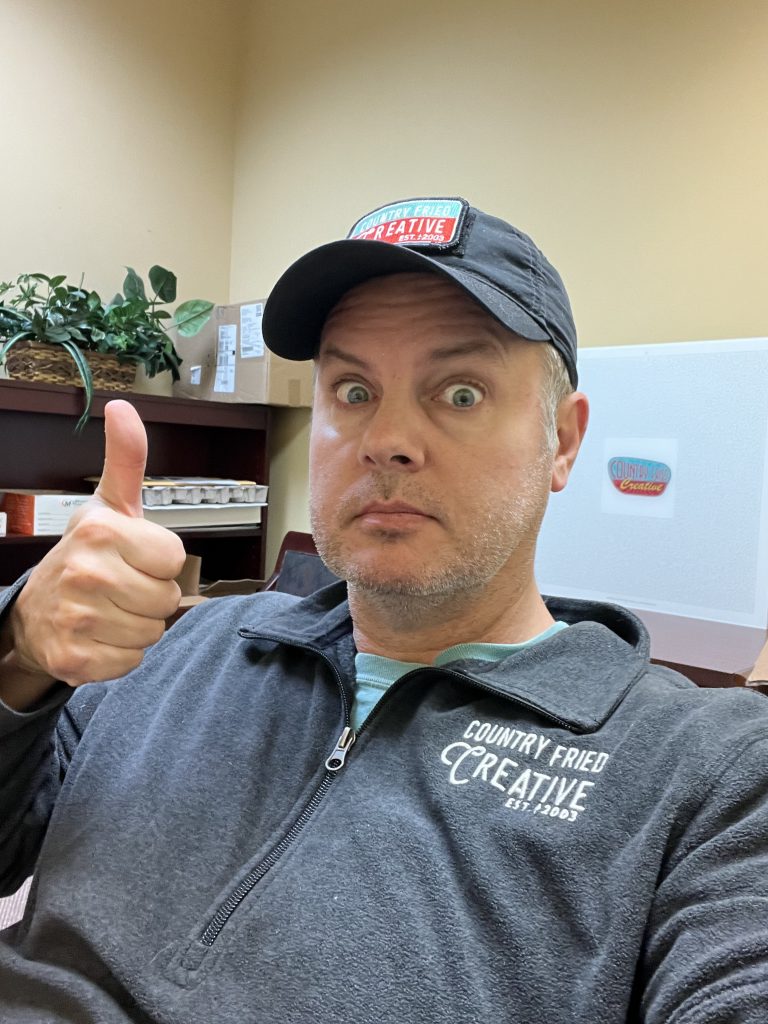
Looking a little shell shocked, the author gives the thumbs up that everything is going to be okay. Photo/Joe Domaleski
So there you have it, my top ten list of least favorite things as a small business owner. You might have noticed a trend that most of the items listed are related to money and people. Although each of those items are frustrating and demanding, they also provide opportunities for growth, learning, resilience, and improvement as a small business owner. Here’s one of my favorite quotes from President Theodore Roosevelt:
Nothing in the world is worth having or worth doing unless it means effort, pain, difficulty… I have never in my life envied a human being who led an easy life.
In next week’s column, I’m going to share my top ten list of my most favorite things as a small business owner. Obviously, the good outweighs the bad or else I wouldn’t still be in business. Nothing worthwhile comes easy. Keep fighting the good fight leaders.
[Joe Domaleski, a Fayette County resident for 25 years, is the owner of Country Fried Creative – an award-winning digital marketing agency located in Peachtree City. His company was the Fayette Chamber’s 2021 Small Business of the Year. Joe is a husband, father of three grown children, and proud Army veteran. He has an MBA from Georgia State University and enjoys sharing his perspectives drawing from thirty years of business leadership experience. ]
by Joe Domaleski | Jul 10, 2023 | Blog, Business, Columnists, Community, News Center, Opinion
When was the last time you went against the grain and did something or went somewhere because it was the less popular thing to do? In a world that often urges conformity and follows an algorithmically generated path, there is something undeniably alluring about taking the road less traveled. This applies in both the real world and the virtual world. It’s a well-established fact that popularity breeds more popularity.
This has been the case throughout history, even before the Internet. This concept is called the “Matthew Effect” or the principle of accumulated advantage. It is named after a verse from the Bible (Matthew 25:29). It suggests that those who are already successful or popular tend to receive even greater benefits and opportunities, while those who are less successful or popular struggle to catch up. Although the term is mostly applied to people, it’s also applicable to places and things. But why does the Matthew Effect happen?
Social Proof: People tend to rely on the behavior of others to determine what is popular or valuable. The more people see others engaging with and endorsing something, the more likely they are to perceive it as valuable or desirable. This creates a positive feedback loop, as the initial popularity attracts even more attention and engagement.
Bandwagon Effect: The bandwagon effect refers to the tendency for individuals to adopt certain behaviors or beliefs simply because others are doing so. It stems from the innate desire to fit in, be accepted, and avoid missing out on something deemed popular or trendy.
Network Effects: In the digital age, network effects from algorithms play a crucial role in the amplification of popularity. When something becomes popular, it can go “viral”. This virality creates a ripple effect, as more people share, discuss, and interact with the popular content or product. As the network grows, the reach and impact of the popular person, place, or thing expands.
Scarcity and Exclusivity: Popularity often creates a sense of scarcity or exclusivity. When someone or something becomes highly sought after or limited in availability, it increases its perceived value. The fear of missing out (FOMO) or the desire to be part of an exclusive group drives people to join in and contribute to the popularity. This creates a cycle where popularity feeds into the perception of scarcity, making the item or content even more coveted.
Social Influence and Conformity: Human beings are social creatures who seek validation and acceptance from their peers. Popular items or content often gain attention because influential individuals or groups endorse or promote them. People are more likely to conform to the opinions and behaviors of those they admire or respect.
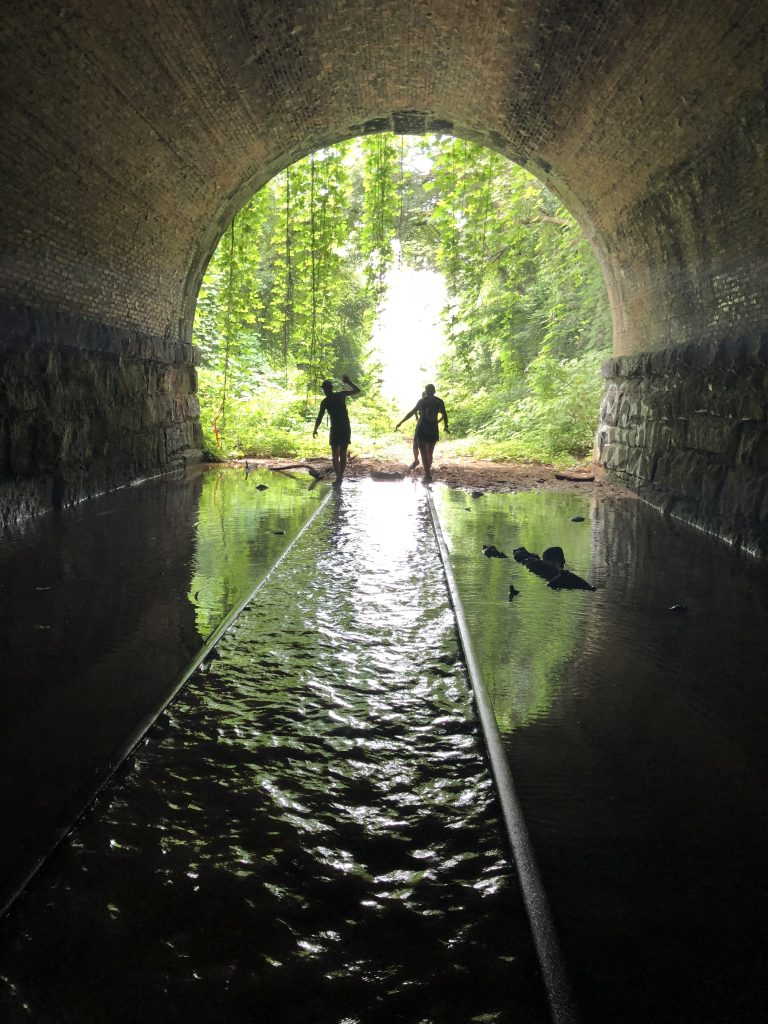
Joe & Mary Catherine Domaleski take the road less traveled by exploring the Southside Beltline trail up in south Atlanta back before it’s developed in 2018. Photo/Joe Domaleski
I run a marketing company and can verify that the above well-known factors come into play when promoting something. So, why would I write an article about non-conformity if I’m a marketer? That’s a fair question. Have you ever read the famous poem by Robert Frost, “The Road Not Taken”? You should, but in the meantime, here’s why I think you should take the road less traveled.
- Experience new adventures: Choosing the road less traveled guarantees you an abundance of extraordinary experiences and unforgettable adventures. Whether it’s exploring uncharted destinations, trying out new restaurants, reading books from new authors, or embarking on unique hobbies, you’ll find yourself in situations that ignite your soul. These experiences not only create lasting memories but also enrich your life with stories worth sharing.
- Find Your Tribe: While following the crowd may provide a sense of belonging, the road less traveled leads you to your true tribe – individuals who share your passions, values, and vision. By embracing your individuality, you attract like-minded people who appreciate and support you for who you truly are. These meaningful connections offer a sense of belonging and support that goes beyond superficial conformity.
- Obtain fulfillment beyond the numbers: In a virtual world obsessed with likes, followers, and metrics, it is easy to lose sight of what truly brings us joy. By breaking away from the crowd and not succumbing to the pressure of liking posts simply for popularity’s sake, we free ourselves from the constraints of seeking external validation. Instead, we redirect our focus towards our own passions, hobbies, and relationships that genuinely bring us happiness and fulfillment.
- Expand your horizons: Choosing the road less traveled inherently involves stepping outside of your comfort zone. It challenges you to confront your fears, embrace uncertainty, and discover untapped potential within yourself. As you venture into uncharted territory, you develop resilience, adaptability, and an open mind. By pushing your boundaries, you acquire a wealth of new experiences, knowledge, and perspectives.
- Open up to creativity and innovation: The well-trodden path often leads to predictability and a lack of innovation. By deviating from the crowd, you open yourself up to new possibilities for creativity and originality. Necessity, as they say, is the mother of invention. When you choose the road less traveled, you’re forced to think outside the box, problem-solve, and explore unconventional ideas. You become a trailblazer, bringing fresh perspectives and inspiring others to break free from the status quo.
- Find your true self: When you choose to diverge from the masses and forge your own path, you open yourself up to a world of self-discovery. By not succumbing to societal expectations and pressures, you grant yourself the freedom to explore who you truly are. Unveiling your unique interests, passions, and talents becomes an exhilarating journey rather than an obligatory checklist. Embracing your individuality fosters a sense of authenticity and allows you to live a life aligned with your core values.
While the allure of conformity may be tempting, choosing the road less traveled is more fun. It allows you to embark on a journey of self-discovery, personal growth, creativity, and meaningful connections. The road less traveled promises an extraordinary life filled with adventure, fulfillment, and a sense of purpose. So, go ahead and try that brand new restaurant, explore less-used trails, listen to new music from lesser known artists, read from works by unknown authors, and promote worthy causes that don’t get a lot of attention. Don’t be a lemming. Avoid the temptation to mindlessly like and follow social media posts just because everyone else is. Seek the unique and stay weird. Dare to be different, embrace your individuality, and set forth on a path uniquely your own. Remember, the road less traveled is where the real magic happens.
[Joe Domaleski, a Fayette County resident for 25 years, is the owner of Country Fried Creative – an award-winning digital marketing agency located in Peachtree City. His company was the Fayette Chamber’s 2021 Small Business of the Year. Joe is a husband, father of three grown children, and proud Army veteran. He has an MBA from Georgia State University and enjoys sharing his perspectives drawing from thirty years of business leadership experience. ]
by Joe Domaleski | Jul 3, 2023 | Blog, Business, Columnists, Community, Front Page, News Center, Opinion
Depending on when you read this, there’s a good chance that I’m either preparing to run, currently running, or have just completed my 40th Peachtree Road Race (aka “The Peachtree” or simply “Peachtree”). Except for a few years when I was on active duty with the Army, I have run every Peachtree since 1981. This iconic race has been a constant presence in my life, marking the passing of years. In this blog post, I would like to take a moment to reflect on my four decades of participation in the Peachtree Road Race and share what this event truly means to me.
I think most everyone knows about the Peachtree Road Race, but in case you don’t know, the Peachtree is a 10K (6.2-mile) road race down historic Peachtree Street in the heart of Atlanta. First run in 1970, the race has been expertly managed by the Atlanta Track Club ever since. Local coach Bill Thorn has run all 53 Peachtree races since that first one in 1970. He recently announced his retirement at age 92 and won’t be running this year. The Peachtree course has changed a little over the years, but the most used and current route starts at Lenox Square in the Buckhead area of Atlanta and runs south along Peachtree Street to 10th Street in Midtown before heading into Piedmont Park. It’s an iconic race known the world over. Before COVID, it was known as the world’s largest 10K race, drawing over 65,000 participants (that’s about half the population of our county!). During COVID, they had a “virtual edition” of the race to keep it going.
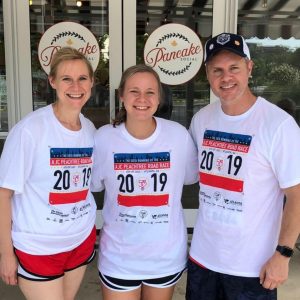
Mary Catherine, Alex, and Joe Domaleski wearing their Peachtree finisher shirts from 2019. Photo/Joe Domaleski
The Peachtree has become part of my life. I first started running it when I was a teenager, back when I could show up and run fast without training. Over the years, I’ve run fast, slow, and mostly “slightly faster” than the average runner. When Mary Catherine and I got married nearly 30 years ago, I let her know that this race was going to be part of our life, and she has honored that and joined in on the fun as well. Our children ran with us over the years, making this a family event. Our oldest daughter, Alex, continues to run the race with us each year.
Looking back on 40 years of running the Peachtree Road Race, I am reminded of the profound personal growth, sweat, soreness, and pride that have accompanied each stride. From my early years as a novice runner to my current “seasoned” status, this race has been a continuous source of self-discovery and self-improvement. It has taught me discipline, resilience, and the power of setting and achieving goals. Each year, I have challenged myself to become a better version of myself, both physically and mentally. That doesn’t always mean running faster, although at one time I was a fast runner.

The author as a much younger, faster runner back in 2002. Photo/Marathon Photo
My fastest Peachtree was 20 years ago, back in 2002. I ran a 38:04, having run a qualifier of 36:25 to get in the “top-seeded” category. With so many runners, the race is divided into waves based on expected finish time and places the fastest runners at the front of the race. The top waves require documented performance to “qualify” for a top spot. For the longest time, my personal goal was to run a sub-40 minute time, and I normally ran in the “sub-seeded” time group ahead of the lettered waves. As I got older, running a sub-42 minute became my new goal as it usually meant I would be in the top 1,000 and start in Wave A. The top 1,000 finishers, regardless of age or gender, were awarded special Top Finisher mugs. I have a collection of them.
Fast forward to 2023, and age has finally caught up with me. My goal this year is just to finish and have fun. We will be in Wave H this year, and I may do a bit of walking. Do you or anyone you know have osteoarthritis? Yep, I have it in my knees, but I’m determined to keep moving forward anyway. It’s important to keep my running streak going and, of course, add another coveted Peachtree finishers shirt to my growing collection. So, what has the race meant to me personally?
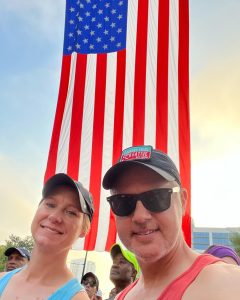
Mary Catherine and Joe Domaleski at the starting line of the 2022 Peachtree Road Race. Photo/Joe Domaleski
A Bond with the Running Community: The Peachtree has brought me into the running community. Over the years, I have forged deep connections with fellow participants, sharing the joy of accomplishment, the camaraderie of training, and the collective celebration of this remarkable event. The sense of unity and camaraderie that permeates the race day is unlike anything I have experienced elsewhere. The shared passion for running has created lasting friendships and a network of support that extends beyond the race itself. You’ll be proud to know that our local community is well represented at the race. Our own Peachtree City Running Club charters two buses to transport runners to the race.
Nostalgia and Milestone Moments: Each Peachtree holds a special place in my heart as a milestone in my running journey. The memories of crossing the start line, hearing the cheers of the crowd, and pushing through the physical and mental challenges have become ingrained in my being. I recall moments of triumph, moments of struggle, and moments of pure joy. These memories serve as a reminder of my own resilience and determination, and they motivate me to keep going, year after year. It’s really hard to describe; you just have to experience it.
Embracing Atlanta’s Spirit – The Peachtree is more than just a race; it is a celebration of Atlanta’s vibrant spirit and rich culture. As I traverse the course, passing iconic landmarks and immersing myself in the cheers of spectators, I feel a profound connection to the city I call home. At the top of “Cardiac Hill,” the race passes by Piedmont Atlanta Hospital, where all of my children were born. Peachtree Street is the heart of Atlanta. The race embodies the city’s resilience, diversity, and unwavering sense of community. It is a reminder of the indomitable spirit that defines Atlanta and inspires me to carry that spirit with me in every aspect of my life. People all across the Atlanta area will be wearing their hard-earned Peachtree finisher shirts after the race. Just seeing another Peachtree finisher creates an instant bond.
Gratitude for the Journey – Above all, I am filled with a deep sense of gratitude. Although I’m not as fast as I once was, I am grateful for my health and the ability to participate in this event year after year. I am grateful for the support of my loved ones, who have cheered me on through every step of this journey. I am grateful for the lessons learned, the friendships made, and the memories created. The Peachtree Road Race has enriched my life in countless ways, and I am honored to have been a part of its legacy.
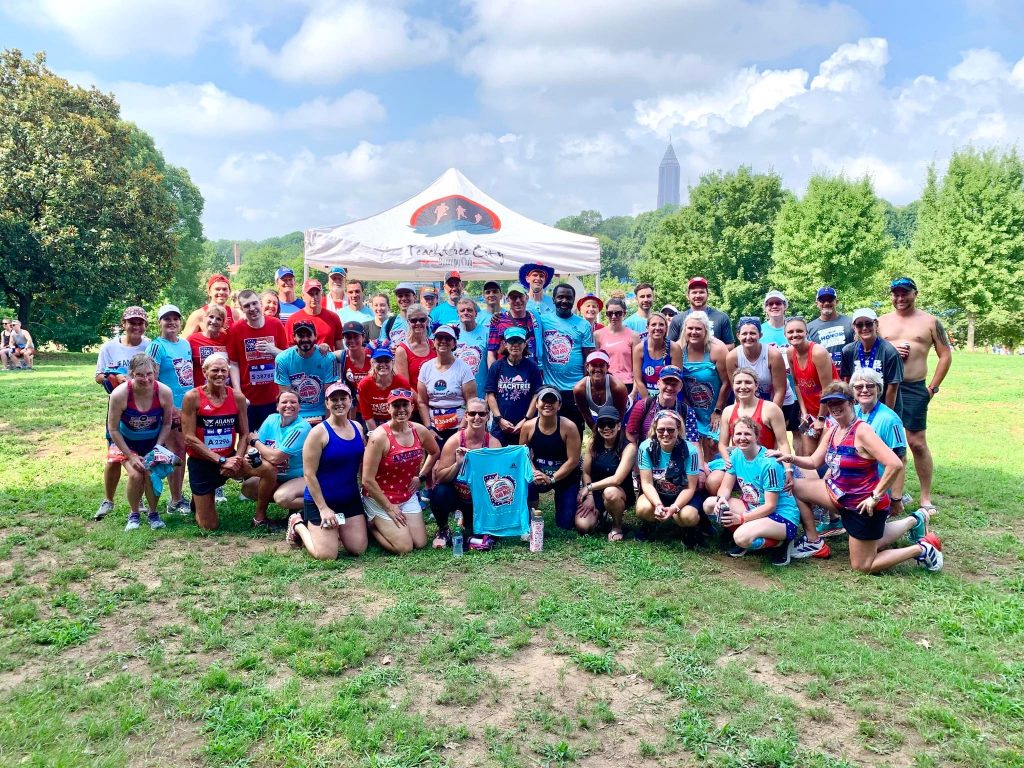
Members of the Peachtree City Running Club at the finish area of the 2022 Peachtree Road Race in Piedmont Park. Photo/Peachtree City Running Club
As I reflect on my 40th Peachtree Road Race, I carry with me a lifetime of memories, lessons, and cherished experiences. This event has shaped me as a runner, as a member of a supportive community, and as an individual. It represents personal growth, camaraderie, and a deep connection to the vibrant city of Atlanta. The Peachtree Road Race is not just a race—it is a part of who I am. And as I cross the finish line once again, I am reminded of the endless possibilities that lie ahead in my ongoing running journey. Are you running the Peachtree this year? If so, meet us at the Peachtree City Running Club tent in the Piedmont Park finish area and say hello. If not, consider running (or walking) it next year.
Happy Birthday, America! We live in the greatest country in the world.
[Joe Domaleski, a Fayette County resident for 25 years, is the owner of Country Fried Creative – an award-winning digital marketing agency located in Peachtree City. His company was the Fayette Chamber’s 2021 Small Business of the Year. Joe is a husband, father of three grown children, and proud Army veteran. He has an MBA from Georgia State University and enjoys sharing his perspectives drawing from thirty years of business leadership experience. ]
by Joe Domaleski | Jun 26, 2023 | Blog, Business, Columnists, Community, Front Page, News Center, Opinion
Keeping up with everything I need to do is a never-ending struggle, and I’m sure I’m not alone in this regard. There’s no doubt that technology has improved the tools for managing tasks and staying organized. However, there’s a downside to all this technology—it has created more inboxes and ways for tasks and to-do’s to fall into my lap. You know what I mean?
Being an effective leader requires staying organized and productive. A leader’s own organizational skills and ability to manage tasks directly impact their team’s success. A personal productivity methodology is essential for leaders to maintain focus, manage time effectively, and prioritize responsibilities. By implementing a productivity system, a leader can streamline workflows, make informed decisions, and ensure their actions align with strategic objectives. A structured methodology allows leaders to optimize productivity, minimize distractions, and dedicate time and energy to high-value tasks that drive results.
When I started my business 20 years ago, I researched different productivity methodologies and systems used by entrepreneurs and business leaders. At the time, the Getting Things Done® (GTD) methodology really resonated with me. Developed by productivity expert David Allen, GTD provides a comprehensive framework for organizing tasks, managing priorities, and achieving a state of “mind like water.” It’s a simple, yet powerful system. While GTD works well with software tools, it is equally effective with a paper-based system. I read Allen’s book “Getting Things Done,” and it opened my eyes to some subtle but powerful ways to stay organized. The GTD methodology has aged well over the years and I still use it. What follows is not a commercial for GTD but simply an overview of what it is and how I use it.
At its core, GTD is centered around five key actions: capturing, clarifying, organizing, reflecting, and engaging with our commitments and responsibilities.
The main idea behind GTD is to free up mental space by externalizing and processing all our tasks, thereby enabling us to focus on execution rather than mental clutter. Key principles of GTD in more detail:
Capture Everything: The first step to achieving a clear mind is to capture every task, idea, and commitment into a trusted system. This can be done using a physical notebook, a digital tool, or a combination of both. By capturing everything, we prevent mental leakage and ensure that no valuable thoughts or tasks slip through the cracks. Personally, I use an app called “Things 3,” which works seamlessly across my iPhone, iPad, Apple Watch, and Mac computer. I can capture tasks from anywhere, and they automatically sync across all my devices. It’s fascinating to tell my watch to remember something and then see it appear on my computer later.
Clarify and Organize: Once tasks are captured, the next step is to clarify their nature and determine the desired outcome. Each task should be processed to determine if it requires immediate action, delegation, deferral, or elimination. Clarifying tasks helps prevent getting overwhelmed and provides clarity on what needs to be done. Once clarified, tasks are organized based on their context, priority, and deadlines. Personally, I go through my inboxed tasks once a day to ensure they are appropriately clarified and organized.
Use an Organizational System: Establishing a reliable organizational system is paramount to GTD’s success. This system may consist of project lists, next-action lists, reference files, and calendars. By having a structured system in place, we can easily access and prioritize our tasks, ensuring that we’re always working on the most important and relevant tasks at any given time. For work organization, my team and I use an online tool called Basecamp, which not only helps us stay organized but also enables seamless collaboration with clients. Personally, I rely on Apple Notes and Apple Calendar, which is integrated into all my devices. My wife and I even use Apple Notes for shared grocery lists, which keeps things efficient and synchronized.

The author feeling a sense of accomplishment after checking off items from a GTD to-do list. Photo/Joe Domaleski
Regular Review and Reflection: GTD emphasizes the importance of periodic reviews to reassess our commitments, projects, and priorities. Regularly reviewing our tasks and goals enables us to make informed decisions about what requires our attention and what can be deferred or eliminated. Reflection helps maintain a clear perspective on our responsibilities and ensures that we’re aligning our actions with our long-term objectives. Personally, I dedicate Sunday evenings to a weekly review and planning session, where I lay out the week ahead and beyond, ensuring I have a clear roadmap for success.
Benefits of a Good Personal Productivity System:
- Enhances Focus and Reduced Stress: A good system, such as GTD, allows us to externalize and organize our thoughts, freeing up mental space for focused action. By knowing exactly what needs to be done and when, we can eliminate the mental clutter that leads to stress and distraction, enabling us to work with greater clarity and purpose.
- Improves Efficiency: With a reliable organizational system in place, we can easily locate and prioritize tasks, making it easier to complete them efficiently. A system like the GTD I use helps us identify the next actionable steps for each task, eliminating decision paralysis and enabling us to make consistent progress.
- Increases Agility: A good methodology equips us with the flexibility to adapt to changing circumstances. By regularly reviewing and reassessing our commitments, we can quickly adjust our priorities and reallocate resources as needed, allowing us to navigate unexpected challenges and seize new opportunities.
- Heightens Creativity and Innovation: When our minds are clear and unburdened, we can tap into our creative potential and generate innovative ideas. Time-tested systems like GTD enable us to focus on important tasks and projects, freeing up mental capacity for creative thinking and problem-solving.
- Inspires Others: Systems like GTD can inspire others by demonstrating the tangible benefits and positive impact of an effective personal productivity system. Although I’m by no means perfect, I do like to hear when someone says, “Joe, you’re a busy person but somehow you seem to get everything done.” While that’s not entirely true, I do strive to be helpful and productive.
Busy times call for powerful tools and system. A system like GTD is a potent tool for enhancing personal productivity in both professional and personal pursuits. Personally, GTD has helped me increase focus, reduce stress, and improve efficiency. Regardless of the system you choose, having an organized and task-focused system is important. Being an organized leader who gets things done not only empowers you to achieve your personal goals but also enables you to inspire and uplift your team and others on their own paths to success. What system do you use to stay organized and productive?
[Joe Domaleski, a Fayette County resident for 25 years, is the owner of Country Fried Creative – an award-winning digital marketing agency located in Peachtree City. His company was the Fayette Chamber’s 2021 Small Business of the Year. Joe is a husband, father of three grown children, and proud Army veteran. He has an MBA from Georgia State University and enjoys sharing his perspectives drawing from thirty years of business leadership experience. ]
by Joe Domaleski | Jun 19, 2023 | Blog, Business, Columnists, Community, News Center, Opinion
In a fast-paced, competitive world, many people seem to be drawn towards sources of short-term media success that are mean-spirited, self-indulgent, or aggressive. As I’ve gotten older, I’ve become more inspired by “rocking chair” wisdom that comes from quiet contemplation and observation. Finding moments of serenity and reflection can be a rare and precious gift.
One such moment can be found in the simple act of watching turtles. We are fortunate here in Fayette County to have some great locations to watch turtles, and I’ll share some of those locations at the end of this article.
Turtles are ancient creatures, with their deliberate movements and unwavering determination, that offer valuable lessons that can be applied to leadership and life in general. Let’s consider the joy of watching turtles and how their characteristics can inspire and guide effective leadership and good living.

Eastern box turtles spotted at The Ridge Nature Area in Fayetteville. Photo/Joe Domaleski
Patience and Perseverance: Watching a turtle gracefully glide through the water or slowly amble across land reminds us of the importance of patience and perseverance. In business and life, we all face numerous challenges and setbacks. Embracing the turtle’s approach can help one remain steadfast in their pursuit of success. Patience allows for thoughtful decision-making, while perseverance ensures that obstacles are met head-on and overcome.
Long-Term Vision: Turtles, with their remarkable lifespans, exemplify the value of a long-term vision. Leaders must cultivate a forward-thinking mindset, focusing not just on short-term gains but on sustained growth and impact. By emulating the turtle’s ability to see beyond immediate circumstances, leaders can make strategic decisions that have lasting benefits for their organizations and stakeholders.

Mary Catherine Domaleski spots a baby turtle along Gingercake Creek. Photo/Joe Domaleski
Adaptability: Turtles have survived for millions of years by adapting to their environments. They can thrive both in water and on land, displaying remarkable adaptability. In the dynamic world of business, adaptability is a crucial trait for leaders. Adaptable leaders can navigate through changing market conditions, embrace new technologies, and respond effectively to unforeseen circumstances. Just as turtles adjust their movements to suit their surroundings, leaders must be willing to adapt their strategies to ensure continued success.
Slow and Steady Progress: The unhurried pace at which turtles move may seem contrary to the fast-paced nature of life. However, the steady progress they make serves as a reminder that success is not always achieved through rapid acceleration. Leaders should be cautious of rushing into decisions without considering the potential consequences. By taking measured steps and prioritizing quality over speed, leaders can build a solid foundation for sustainable growth and long-term success.
Balance and Self-Care: Turtles, whether basking in the sun or retreating into their shells, demonstrate the importance of balance and self-care. In the pursuit of goals, leaders often neglect their own well-being. However, taking time to recharge and nurture oneself is essential for effective leadership. By prioritizing work-life balance, cultivating healthy habits, and fostering a supportive environment, leaders can sustain their own well-being while nurturing the well-being of their teams.
So where are all the turtles in Fayette County? Here are some of my favorite places to see them:
- The Ridge Nature Area in Fayetteville: This is the absolute best place to see turtles in their natural habitat. The park is actually a turtle sanctuary, and researchers from Clayton State University even study turtles there. It is expertly managed and maintained by the City of Fayetteville and the Southern Conservation Trust.
- Flat Creek Nature Area Boardwalk in Peachtree City: This amazing place allows you to walk out almost half a mile into the heart of Peachtree City to see the wetlands of Flat Creek up close. This is the only structure of its kind and length in the county. Unfortunately, at the time of writing this article the boardwalk has been closed due to storm damage. Hopefully, the city will repair it soon.
- Line Creek Nature Area in Peachtree City: This park is not just the namesake of a popular brewery; it’s a gem of a park that forms the natural border between Fayette and Coweta counties. This park is very popular with residents and visitors. There are lots of great turtle-watching opportunities here amidst the rapids, rocks, and even the old mill ruins of the Line Creek.
- Trilith in Fayetteville: Despite the hustle and bustle of the nearby movie studios and the Town of Trilith, there’s an impressive pond and natural trail network at Trilith. Although the pond is a great place to see turtles, there’s an even better spot along the short boardwalk on the nature trail at the east end of the property. From the boardwalk, you can see the wetlands that are part of Whitewater Creek.

A family of turtles at Sams Lake. Photo/Mary Catherine Domaleski
- Sams Lake Bird Sanctuary south of Fayetteville: Nestled between busy Georgia Highway 85 and the less busy Old Senoia Road, this place has attracted bird watchers from all over the state. It’s also a fantastic place to see turtles, frogs, snakes (be careful), and even a beaver dam!
- Lake Horton in Brooks: A fantastic park to fish, it’s also a great place to see all kinds of wildlife and reptiles, including turtles. There’s even a small bamboo forest. Owned by Fayette County Water and managed by Fayette County Parks & Recreation, this is another great place for enjoying nature.
In the midst of a busy and chaotic world, finding inspiration in unexpected places can be transformative. It’s my hope that our community continues to preserve nature wherever and whenever possible. The joy of watching turtles allows us to reflect on the wisdom they embody and apply those lessons to leadership. By embracing patience, perseverance, adaptability, slow and steady progress, and a focus on balance and self-care, leaders can navigate the challenges they face with grace and poise. So, take a moment to observe the turtles and allow their wisdom to guide you on your leadership journey. If you see me at one of the area parks, please say hello.
[Joe Domaleski, a Fayette County resident for 25 years, is the owner of Country Fried Creative – an award-winning digital marketing agency located in Peachtree City. His company was the Fayette Chamber’s 2021 Small Business of the Year. Joe is a husband, father of three grown children, and proud Army veteran. He has an MBA from Georgia State University and enjoys sharing his perspectives drawing from thirty years of business leadership experience. ]










